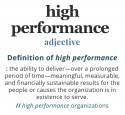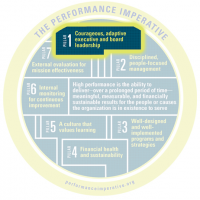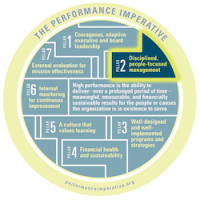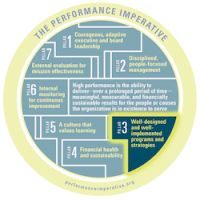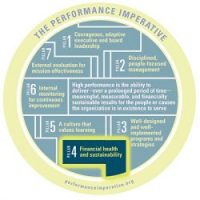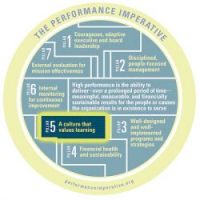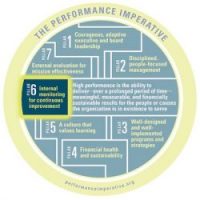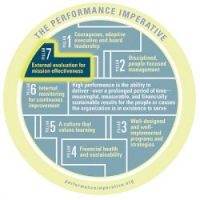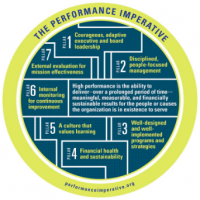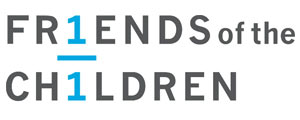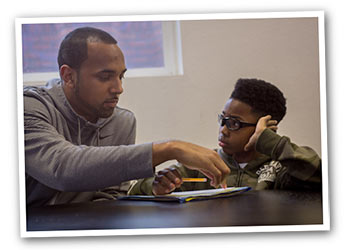
When the Social Innovation Fund (SIF) awarded a $4 million grant to Friends of the Children, President Terri Sorensen knew she had an unprecedented opportunity. If she could raise the $9.4 million match the grant required, hundreds more children in foster care and high-poverty, high-crime neighborhoods would receive professional mentoring—from Kindergarten through 12th grade—increasing their odds of graduation and success in life.
Just before learning of the SIF grant, Terri had agreed to beta test the Performance Practice (formerly PIOSA) for the Leap Ambassadors Community. In the face of the opportunity (and challenge!) to reach 60% more youth, any president would have been tempted to move the Performance Practice off the to-do list. Suspecting, however, that it might be helpful rather than a distracting “extra” task, Terri decided to move forward.
The point of scaling isn’t just to serve more children; it’s to help more children succeed
—Terri Sorensen
President, Friends of the Children
“I’m so glad we were asked to test the Performance Practice,” she said after going through the self-assessment with her national leadership team. “It’s a wonderful opportunity to celebrate how far we’ve come and… to make sure we are considering all the right questions and next steps to reach our goals.”
After completing two of the seven pillars, the national leadership team realized that it did not have to be a one-and-done exercise. A few months later, the opportunity to use the Performance Practice in Friends chapters across the country presented itself.
Going National
Terri knew the Friends executive directors were fully committed. But with half of all executive directors in place for two years or less and several chapters in planning stages, leadership development was necessarily a high priority. All of the executive directors had to be fully supported and able to make sure the Friends model was implemented as designed. Otherwise, how could they reasonably expect to achieve positive outcomes?
“The point of scaling isn’t just to serve more children; it’s to help more children succeed,” said Terri. “That’s why each and every one of our chapters has to be high-performing.”
Executive and board leadership development had been a topic of conversation on monthly network leadership calls for months. But the team wasn’t sure where to take the conversations next.
That’s when a new idea began to take shape. What if they used the Performance Imperative’s Pillar 1—courageous, adaptive executive and board leadership—to frame the conversation?
“At National, we had beta tested that part of the Performance Practice within our own team, and it occurred to us that the Performance Practice can help the entire network do even better,” Terri said. “We think the process can help us build on our strengths, help each other, and get executive directors of new chapters off to a good start.”
Follow Friends’ Year of Leadership Development
Friends of the Children’s plan will change depending on its findings, but their intention is clear: to introduce the Performance Practice, invite all chapters to complete pillar 1, and then return to share and discuss what they’ve learned. In every 2017 monthly network leadership call, they will pick a leadership issue of shared concern and ask one executive director to facilitate the conversation.
Terri has agreed to share what they learn and how it informs their ongoing process. Follow along here.
 February: Getting Buy-In
February: Getting Buy-In
In the executive directors’ February conference call, the national leadership shared how the Performance Practice beta test exercise had both affirmed numerous strengths and helped them see areas for growth. Leadership development issues had come up repeatedly in previous calls—someone would pipe up and ask for input and they would hear popcorn responses from one or two people. Members of the national leadership team suggested that using the Performance Practice would allow them all to work from the same questions.
“I don’t like the idea of leading by carrots and sticks,” said Terri. “Chapter executive directors are leaders themselves, and it only makes sense to use something like the Performance Practice if they are fully invested and believe it will help them get where they need to go.”
We build intentional long-term relationships with children, because that’s what it takes to help them succeed. As a network, we do the same with each other, and the Performance Practice is going to help our learning community’s growth.
—Sarah Beiderman
Expansion Fund and Grants Manager
Friends of the Children
People welcomed the idea. In particular, executive directors liked that the Performance Practice had been developed by 50+ content-area experts from across the nonprofit sector—practitioners, consultants, researchers, funders, and policymakers—as well as vetted by the entire Leap Ambassadors Community. They were excited about being guided by a set of questions that define high performance, described in the Performance Imperative as “the ability to deliver—over a prolonged period of time—meaningful, measurable, and financially sustainable results for the people or causes an organization exists to serve.” It fit their commitment to breaking the cycle of generational poverty perfectly.
By the end of the call, it started to feel like a generative process. “We build intentional long-term relationships with children, because that’s what it takes to help them succeed,” said Sarah Beiderman, Expansion Fund and Grants Manager. “As a network, we do the same with each other, and the Performance Practice is going to help our learning community’s growth.”
Since everyone had agreed in the February call to use Pillar 1 of the Performance Practice as a guide, the March conversation turned to process. How would chapters complete the self-assessment? Terri described how the national leadership team members had completed the same section of the Performance Practice individually and then discussed it together, but she offered other ways to approach it as well.
 March: Agreeing on the Process
March: Agreeing on the Process
I’m excited about learning more and beginning to use the Performance Practice, and I hope we’ll have opportunities for longer training sessions and discussions so that we can learn from each other.
—Kelly McKee
Executive director
Friends of the Children – Seattle
Who should be involved? Should an executive director complete it on her own, or should she involve her entire leadership team, and maybe even the board, since pillar 1 is about executive and board leadership? If involving the team, would each person complete it individually before getting together to discuss, or would they discuss each question as a group and come to consensus?
Several executive directors felt that the self-assessment could guide organizational conversations and wanted to include their leadership teams. In the end, the group decided that each chapter should approach it in the way that made the most sense to them. Their Performance Practice ratings and rationales would be only for themselves. The purpose was learning, not accountability.
“I’m excited about learning more and beginning to use the Performance Practice, and I hope we’ll have opportunities for longer training sessions and discussions so that we can learn from each other,” said Kelly McKee, executive director of the Seattle chapter. “I see a lot of potential for strengthening our organization and our leadership, now and in the future.”
Next month, after completing the Performance Practice in their own chapters, everyone will come back to discuss.
 April: Debrief
April: Debrief
In April’s network executive director call, members of the national leadership team withdrew, allowing executive directors to have a private, peer-to-peer discussion about their Performance Practice experience. “There was such good organic conversation,” observed National HR Director Cheryl Jones, who stayed to facilitate, “on topics from managing two-tier boards to assessing effectiveness.” The bulk of the conversation, though, focused on best practices in executive director review processes.
It sparked a lot of really good conversations, conversations you just don’t think about having until a tool like the Performance Practice draws your attention to them.
—Cheryl Jones
National HR Director
Friends of the Children
Some had engaged their leadership teams, but many executive directors—wanting to familiarize themselves better with the Performance Practice before involving others—had completed it on their own. Later, they felt, it would be valuable to invite senior leaders and board members to be part of the process.
The group decided collectively to spend time during the next network executive director call to share experiences and resources for board development, which emerged as a major topic. “It sparked a lot of really good conversations, conversations you just don’t think about having until a tool like the Performance Practice draws your attention to them,” said Cheryl.
 June: Sacred Time for Reflection
June: Sacred Time for Reflection
A good deal of time in each call is now reserved for reflective conversation, a welcome departure from a typical task-oriented meeting. In each call, selected parts of the Performance Practice’s Pillar 1—such as recruiting, developing, engaging and retaining talent—are the collectively pre-determined topics of facilitated discussion. Executive directors liked having someone from National facilitate the conversation, so that has become standardized.
Being an executive director sometimes feels like you’re on an island by yourself, so having 8-12 brilliant minds bounce ideas off each other every month has been immensely helpful. It has become our sacred time for reflection, and I look forward to it.
—Yi-Chin Chen
Executive Director
Friends of the Children, Boston
In June, we checked in with Yi-Chin Chen, executive director of the Boston chapter, and she told us the Performance Practice finds its way into other parts of the 90-minute calls. In May and June, monthly review of the network dashboard, for example, felt different from past calls: Conversation about the dashboard—which includes chapter-level indicators of program performance, board engagement, staff retention, and financial health—was richer. “The Performance Practice is nuanced and provides a framework to help us think about what lies behind the numbers, the reasons for variations, and the many small steps we may need to take to improve on any one indicator,” she said.
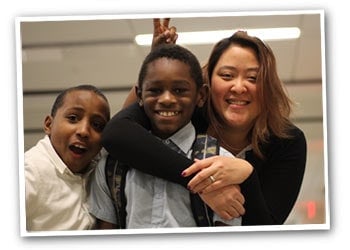
“Some issues are so daunting that our natural, human inclination is to push them to the back of our minds,” Yi-Chin observed. “Our monthly calls bring those issues to the forefront and give us a chance to chip away at them. Just knowing that we’ll be reviewing the network dashboard and really reflecting on what it shows… that alone is enough to keep the important issues in the forefront of our minds.”
The knowledge that others are struggling with the same problems is also validating. “Being an executive director sometimes feels like you’re on an island by yourself, so having 8-12 brilliant minds bounce ideas off each other every month has been immensely helpful. It has become our sacred time for reflection, and I look forward to it,” she said.
 July: An Epiphany
July: An Epiphany
Since Friends embarked on their year-long journey of exploring the Performance Practice’s leadership pillar, things have taken an unexpected but exciting turn. In July, President Terri Sorensen, shared an epiphany with the executive directors: “We have to think more holistically about performance.”
Three experiences had coalesced for her. First, Terri coaches new executive directors and often sees more progress in programming than other organizational areas. Yet she knows that organizational strength in all areas is necessary to sustain program success. Second, the rich leadership development conversations executive directors were having in the monthly calls highlighted the interconnectedness across organizational areas. Third, the Social Innovation Fund (SIF) grant required the national office to choose a monitoring tool for those chapters receiving SIF funds.
Going through selected questions from all seven pillars of the Performance Practice once a year isn’t busy work. It’s about paying attention to the big picture and digging deeper in the areas where we need to focus.
—Megan Lewis
Executive Director
Friends of the Children, Portland, OR
“The purpose of a monitoring tool can’t be limited to meeting funder requirements,” Terri explained. “It has to help us ensure that our chapters are strong enough to provide the highest quality services and produce the best possible outcomes for children.” SIF requirements that are highly focused on financial sustainability and external evaluation are now supplemented with two or three of the most critical and relevant questions about leadership, disciplined, people-focused management, culture of learning, and internal monitoring for continuous improvement from the Performance Practice’s seven pillars.
Terri realized that a monitoring tool for SIF sub-grantees that addresses overall organizational strength is equally relevant to all chapters. So why limit its use? Terri presented her draft list of questions from the relevant pillars of the Performance Practice, and suggested that all chapters work through them annually. The SIF program officer had approved the draft, and so did chapter executive directors.
“Going through selected questions from all seven pillars of the Performance Practice once a year isn’t busy work,” said Megan Lewis, Executive Director of the Portland chapter. “It’s about paying attention to the big picture and digging deeper in the areas where we need to focus.” In the end, what started as a monitoring tool will perhaps become known as a learning and organizational development tool.
 September: Digging Deeper
September: Digging Deeper
As Friends of the Children’s year of Performance Practice-facilitated leadership development draws to a close, we wondered if local executive directors are able to reflect and learn in a way that is meaningful enough to prompt them to make improvements in their own chapters. Is 30 minutes dedicated to a Performance Practice topic in monthly calls enough?
Amanda Squibb, executive director of the Friends of the Children – Klamath Basin chapter in Oregon, shared her take. “The Performance Practice discussions bring up new and timely questions, and my peers’ different perspectives always get me thinking,” she said. “Many of us may have the same problems, but the reasons and solutions may vary. When I get off the call, I’m glad I have a framework to consult. I dig deeper into the Performance Practice on my own, and it helps me figure out what the root causes for a problem might be in my chapter.”
Increasing Board Engagement. Amanda’s efforts to dig deeper on her own started with a question familiar to executive directors of nonprofits across the country: How can I increase board engagement?
The Performance Practice has been a way to untangle things and break them down to their root causes, which helps me figure out what I need to do.
— Amanda Squibb
Executive Director
Friends of the Children – Klamath Basin, OR
The Performance Practice proof points for Pillar 1 (courageous and adaptive executive and board leadership) got Amanda thinking about possible reasons for low engagement and encouraged her to take action. For one, she called board members to better understand their motivations for being on the board. She learned that typical board tasks like voting on manuals and new policies weren’t enough; they wanted to be closer to the organization’s mission. Amanda mentioned some needs. One board member connected her with his fiancée, a social work student who is now providing pro-bono mental health trainings and support to the chapter. Others helped change security lights and replace broken windows. These day-to-day activities, board members said, made them feel more connected to the mission.
Introducing the Network Dashboard. Amanda also introduced the network dashboard—a visualization of key success metrics that compare Klamath Basin to all the other chapters in the network—in bi-monthly board meetings. The indicators of success (which include board engagement) and national comparisons fired up the board members and gave them new focus.
Based on the insights from the comparison dashboard, the board set improvement goals and made plans for how to achieve them. Klamath Basin may be one of the few small, rural chapter in Friends of the Children’s network, but its achievements will, they agreed, equal those of larger, urban chapters!
Triggering Change in Incremental Doses. So yes, half-hour, monthly Performance Practice discussions with peers is enough to spark reflection and trigger change, at least for this executive director. “It all comes down to finding a simpler way to look at something that feels big and complicated,” Amanda said. “The Performance Practice has been a way to untangle things and break them down to their root causes, which helps me figure out what I need to do.”
Do you want to assess and improve your organization’s executive and board leadership? Check out Pillar #1 in the Performance Imperative and Performance Practice (formerly PIOSA).
Last Updated: September 26, 2018
